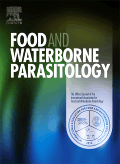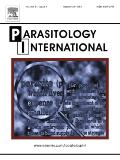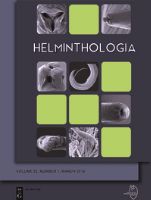
JOURNAL OF HELMINTHOLOGY
Scope & Guideline
Unraveling the mysteries of helminth parasites.
Introduction
Aims and Scopes
- Taxonomy and Systematics of Helminths:
The journal frequently publishes articles focused on the description of new helminth species and the revision of existing taxa, utilizing morphological and molecular techniques to clarify phylogenetic relationships among helminths. - Host-Parasite Interactions:
Research on the dynamics of interactions between helminths and their hosts is a core focus, examining how these relationships affect host health, immune response, and ecological balance. - Epidemiology and Public Health:
The journal addresses the epidemiological aspects of helminth infections, including prevalence studies, risk factors, and impacts on public health, particularly in relation to zoonotic diseases. - Control and Management Strategies:
Papers exploring the efficacy of various therapeutic approaches, including traditional and novel antihelminthic treatments, as well as integrated pest management strategies in agricultural settings, are central to the journal's mission. - Environmental and Ecological Studies:
The *Journal of Helminthology* emphasizes research on the ecological roles of helminths, their responses to environmental changes, and their impact on biodiversity and ecosystem health.
Trending and Emerging
- Molecular and Genomic Approaches:
Recent articles increasingly utilize molecular techniques, such as next-generation sequencing and genomic analysis, to unravel the complexities of helminth biology, including species identification and evolutionary relationships. - Impact of Climate Change on Helminth Populations:
Emerging research is focusing on how climate change affects helminth distribution, life cycles, and host interactions, emphasizing the need for adaptive management in both wildlife and agricultural contexts. - Integrated Control Strategies:
There is a growing trend towards exploring integrated control strategies that combine biological, chemical, and environmental management practices to address helminth infections in both humans and animals. - Helminth Microbiomes and Ecosystem Interactions:
Research into the interactions between helminths, their microbiomes, and the broader ecosystem is gaining traction, highlighting the importance of understanding these relationships for ecological health. - Zoonotic Helminth Infections:
With increasing global mobility and environmental changes, studies addressing zoonotic helminths and their transmission dynamics to humans are becoming more prevalent, reflecting public health priorities.
Declining or Waning
- Traditional Morphological Studies:
While still important, there is a noticeable decline in purely morphological studies of helminths as researchers increasingly adopt molecular techniques that provide deeper insights into phylogeny and taxonomy. - Studies on Helminth Parasites in Domestic Animals:
Research focused on helminths of domestic animals is becoming less prominent, possibly due to a shift towards wildlife and zoonotic studies, reflecting growing concerns about biodiversity and ecosystem health. - Single-Species Infection Studies:
There is a decreasing trend in studies investigating single-species infections, as the complexity of co-infections and multi-species interactions gains more attention in contemporary research.
Similar Journals

Parasites Hosts and Diseases
Unraveling the Mysteries of Parasites and Their HostsParasites Hosts and Diseases is an emerging academic journal focusing on the intricate relationships between parasites, their hosts, and associated diseases. Published by the Korean Society of Parasitology in collaboration with Seoul National University College of Medicine, this journal is a significant contribution to the fields of Infectious Diseases and Parasitology, and it has secured a place in the Q3 category for both disciplines as of 2023. With an ISSN of 2982-5164 and an E-ISSN of 2982-6799, this open-access publication aims to foster scholarly communication and provide a platform for researchers to disseminate their findings on critical issues related to parasitic infections and the pathogenesis thereof. Although it is still in the early stages of its history, the journal has already positioned itself as a useful resource within its field, with Scopus rankings showing it as 48th of 79 in Parasitology and 210th of 344 in Infectious Diseases, indicating its growing influence and the potential for impactful research. Situated in South Korea, and via its open-access model, Parasites Hosts and Diseases is committed to reaching a global audience of scientists, healthcare professionals, and students, all dedicated to understanding and combating the challenges posed by parasitic diseases.

REVISTA BRASILEIRA DE PARASITOLOGIA VETERINARIA
Exploring the Frontiers of Veterinary Parasitology KnowledgeThe REVISTA BRASILEIRA DE PARASITOLOGIA VETERINARIA, published by the BRAZILIAN COLLEGE OF VETERINARY PARASITOLOGY, serves as a premier platform for disseminating groundbreaking research and advancements in the field of veterinary parasitology. Since its transition to Open Access in 2007, the journal has significantly contributed to fostering global collaboration and knowledge sharing among researchers and practitioners. Situated in Brazil, this esteemed journal features a diverse range of studies focused on the latest developments and challenges in veterinary and parasitological sciences. With a commendable Q3 ranking in Parasitology and Q2 ranking in Veterinary (miscellaneous) for 2023, it is recognized for its growing impact in the academic community, particularly holding positions in the 60th percentile for General Veterinary and 37th percentile in Parasitology. Researchers, professionals, and students interested in enriching their understanding of veterinary parasitology will find this journal a vital resource, as it bridges regional expertise with global research trends, thus embracing a holistic approach to veterinary health.

Persian Journal of Acarology
Exploring the intricate world of mites and ticks.The Persian Journal of Acarology, published by the Acariology Society of Iran, stands as a pivotal resource in the fields of Animal Science, Zoology, and Insect Science. Established in 2012 as an open-access platform, this journal provides researchers and academics with a rich repository of peer-reviewed articles focused on the study of acarology, encompassing both basic and applied research. With its current ranking in the Q3 category and significant Scopus rankings in related fields, the journal fosters scholarly communication among professionals, facilitating the advancement of acarology globally. The journal’s commitment to open access ensures that valuable research is available to a wide audience, supporting both emerging and established scientists in their pursuit of knowledge. With contributions from distinguished authors and a steady trajectory of growth, the Persian Journal of Acarology is a vital tool for those invested in the future of acarological studies and applied entomology.

MEDICAL AND VETERINARY ENTOMOLOGY
Bridging Entomology and Health for a Safer TomorrowMEDICAL AND VETERINARY ENTOMOLOGY is a leading journal published by Wiley that focuses on the intricate relationships between insects and their roles in both medical and veterinary contexts. With an ISSN of 0269-283X and an E-ISSN of 1365-2915, this journal has established itself as an essential resource for researchers, professionals, and students alike, showcasing critical studies that advance our understanding of entomology's impact on public health and animal welfare. The journal spans from 1987 to 2024, indicating its long-standing contribution to the field, and it continues to maintain a strong reputation with an impressive categorization in the Q1 and Q2 quartiles across notable disciplines such as Insect Science and Veterinary Studies. While it is not an Open Access journal, its rigorous editorial standards and high impact factor make it a vital platform that attracts quality research in the ecology, evolution, and control of medically and veterinary important insects. As the field evolves, MEDICAL AND VETERINARY ENTOMOLOGY remains a pivotal asset for scholars striving to tackle current challenges and improve strategies in entomological research.

Food and Waterborne Parasitology
Bridging Knowledge and Practice for Safer Food and WaterFood and Waterborne Parasitology is a premier open-access journal published by ELSEVIER, dedicated to the critical study of parasites affecting food and water safety. Since its inception in 2015, the journal has significantly contributed to research in the fields of epidemiology, food science, and parasitology, achieving impressive rankings in its categories with a Q1 status in Food Science and a Q2 in both Epidemiology and Parasitology as of 2023. Addressed from RADARWEG 29, 1043 NX Amsterdam, Netherlands, it garners attention for its accessible content, aiming to elevate the understanding of the impact of parasitic organisms on public health and food security. With its open-access model, the journal enhances visibility and dissemination of research findings, fostering collaboration and innovation among researchers, professionals, and students alike. By bridging scientific inquiry with practical applications, Food and Waterborne Parasitology plays a pivotal role in addressing global health challenges and advancing knowledge in this vital area of study.

FOLIA PARASITOLOGICA
Advancing the Science of Parasitology.FOLIA PARASITOLOGICA is a distinguished scholarly journal published in the Czech Republic, focusing on the field of parasitology. With a commitment to advancing knowledge in parasitology, the journal covers a wide array of topics including the biology and control of parasites, host-parasite interactions, and epidemiology. Having been in circulation since 1971 and currently converging its years of research until 2024, FOLIA PARASITOLOGICA has established itself as a vital resource for researchers, professionals, and students in immunology and microbiology, currently ranked in the Q3 category for Parasitology. Although it does not operate under an open-access model, the journal's relevance is underscored by its Scopus ranking, where it is positioned 47th out of 79 in the field, reflecting the high standards of research it publishes. By hosting a range of studies and reviews, FOLIA PARASITOLOGICA continues to contribute significantly to the scientific community, fostering advancements that enhance our understanding and management of parasitic diseases.

PARASITOLOGY INTERNATIONAL
Unraveling the Complexities of Host-Parasite InteractionsParasitology International, published by Elsevier Ireland Ltd, is a leading journal in the field of parasitology and infectious diseases. With its ISSN 1383-5769 and E-ISSN 1873-0329, this esteemed journal provides a platform for the dissemination of high-quality research covering various aspects of parasitic diseases and their treatment. Recognized for its rigorous peer-review process, Parasitology International currently holds a commendable Q2 ranking in both the Infectious Diseases and Parasitology categories for 2023. The journal's Scopus rankings further enhance its reputation, positioning it at Rank #33/79 in Parasitology and Rank #166/344 in Infectious Diseases. Covering a broad range of topics from host-parasite interactions to novel treatments, this journal plays a pivotal role in advancing knowledge and fostering innovation within the research community. Though it does not currently operate as an open access journal, it continues to attract contributions from leading experts around the world, making it an invaluable resource for researchers, professionals, and students committed to understanding and combating parasitic diseases.

HELMINTHOLOGIA
Bridging Knowledge Gaps in Parasitology and ZoologyHELMINTHOLOGIA is a distinguished open-access journal published by SCIENDO, dedicated to advancing our understanding of parasitology and its relationship with animal science. Since its establishment in 1979, this journal has been a vital resource for researchers, professionals, and students in the fields of Animal Science and Zoology as well as Parasitology, featuring comprehensive research articles that span a diverse array of topics pertaining to helminths and their impact on host organisms. With an impressive impact factor and a commendable ranking in both Scopus categories (Rank #275 in Animal Science and Zoology and Rank #55 in Parasitology), it serves as a crucial platform for disseminating knowledge that informs both academic inquiry and practical application. Operating out of Poland, HELMINTHOLOGIA has embraced an open-access model since 2006, ensuring that its content is readily available to a global audience, thereby fostering collaboration and innovation in parasitic research.

ACTA PARASITOLOGICA
Unveiling Insights in Parasitic ResearchACTA PARASITOLOGICA, published by SPRINGER INT PUBL AG, stands as a pivotal journal within the field of Parasitology, boasting an ISSN of 1230-2821 and an E-ISSN of 1896-1851. Based in Germany, it has been providing valuable insights and research contributions since its inception, with publishing years converging from 1992 to 1994 and consistently from 1996 to 2024. The journal is recognized in the 2023 Category Quartiles as Q3 in Parasitology, indicating its significant impact and growing influence in the discipline, reflected in its Rank #43/79 in the Scopus Ranks for Immunology and Microbiology (Parasitology). Although not currently available in an Open Access format, ACTA PARASITOLOGICA remains a critical resource for researchers, professionals, and students alike, serving as a platform for the latest developments, methodologies, and discoveries in parasitic research. Its ongoing commitment to advancing the understanding of parasitic diseases and their impact on health and ecosystems underscores its importance in both academia and public health.

Current Research in Parasitology & Vector-Borne Diseases
Fostering interdisciplinary dialogue in parasitology research.Current Research in Parasitology & Vector-Borne Diseases, published by ELSEVIER, is an influential journal dedicated to advancing the understanding of parasitology and vector-borne diseases. With an ISSN of 2667-114X, this journal is highly esteemed in the field, holding a prestigious Q1 quartile ranking in categories such as Animal Science and Zoology, Insect Science, and Parasitology, as well as a notable Q2 ranking in Virology for 2023. The journal's focus spans a crucial intersection of disciplines, offering a platform for innovative research that directly addresses global health challenges posed by parasites and vectors. Researchers benefit from its robust open-access model, which facilitates unrestricted dissemination of knowledge, making essential findings accessible to a wider audience. The journal continues to play a pivotal role in fostering scholarly dialogue and interdisciplinary collaboration within the scientific community, serving as a vital resource for professionals, students, and academicians interested in the dynamic and evolving field of parasitology.